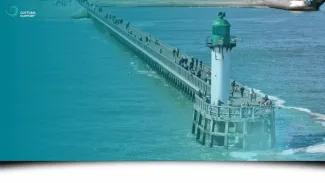The Port of Calais
The Port of Calais is one of the biggest in France, and the busiest crossing point with the UK. In 2022, nearly 38 million tonnes were processed through the port.
True to its origins as a little fishing village, one of the main cargoes of Calais Port is fish. In 2022, more than 28 thousand tonnes – an estimated €87 million’s worth – came through the port.
More than 1.25 million tonnes of general cargo was processed through Calais last year. Sand and stone destined for Norway and Finland make up a large amount of this trade.
The history of the Port of Calais
The Port of Calais was a small fishing village in its infancy, known as Caletum by the Romans. In the 10th century, the Count of Flanders developed the port and the first charter was awarded in the 12th century. Recognising the need for defence, the city was fortified in the 13th century.
Desiring the Port of Calais for English trade due to its location opposite Dover and built-up fortifications, the English lay siege to the city and conquered it in the early 14th century.
In the early 16th century, the English expanded the port with two more locks and a new stone dock. Calais was liberated by France shortly afterwards, and nicknamed “Pays Reconquis” (reconquered country).
Throughout the 17th, 18th, and 19th centuries, more docks were added to the Port of Calais by both merchants and the French army. The first train arrived in Calais in 1848, beginning the movement of goods by rail from the port.
Between World War I and World War II, the Port of Calais began expansion with machines and hydraulic cranes. In World War II, the city was heavily damaged by artillery and wasn’t liberated until 1944.
Reconstruction of the port and city began immediately after the war, and in 1980 the cross-channel terminal was opened for both passengers and goods moving to and from the UK. The first Ro/Ro terminal was established in 1992, with additional freight locations being opened throughout the last 30 years to manage growing volumes.
Customs Support Calais
Customs Support Calais manages customs clearance for goods moving in and out of the port, as well as transit clearance for goods travelling through the community.
Did you know?
- The Port of Calais is only 21 miles from the Port of Dover, making it the closest French port to England. The white cliffs of Dover can be seen from Calais on a bright and clear day.
- Calais is such an important location on the coast of France that it was used as a diversion for D-Day in World War II. False intelligence was given to the Germans that Calais would be the landing point, whilst Allied forces stormed the beaches of Normandy.
- In the 15th century, half of Calais was working with the English wool trade.
Need Customs Support in Calais?
Working with our colleagues in the UK and throughout Europe, Customs Support Calais is here to help you clear your goods in a compliant and timely manner. Contact us for more information.














